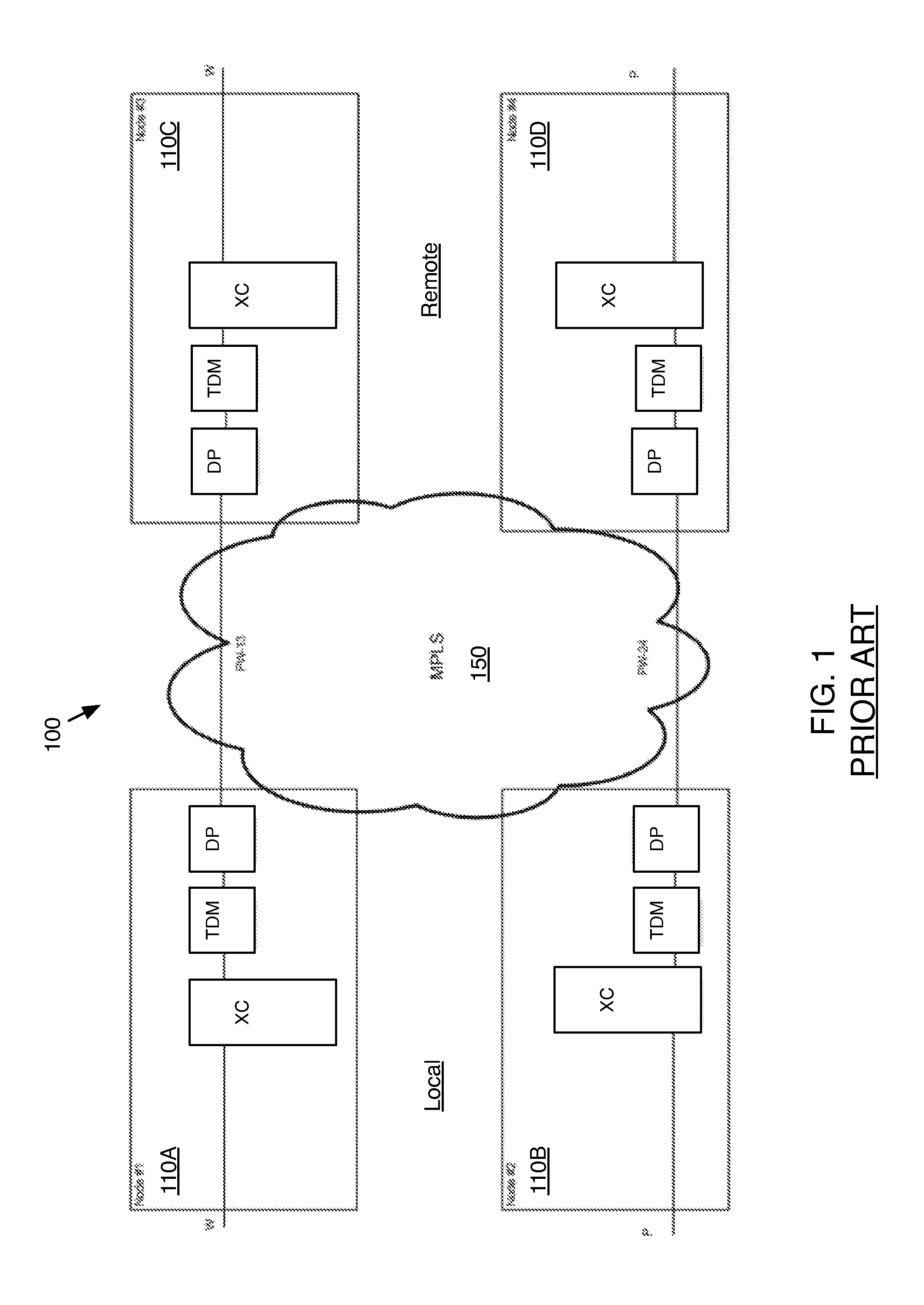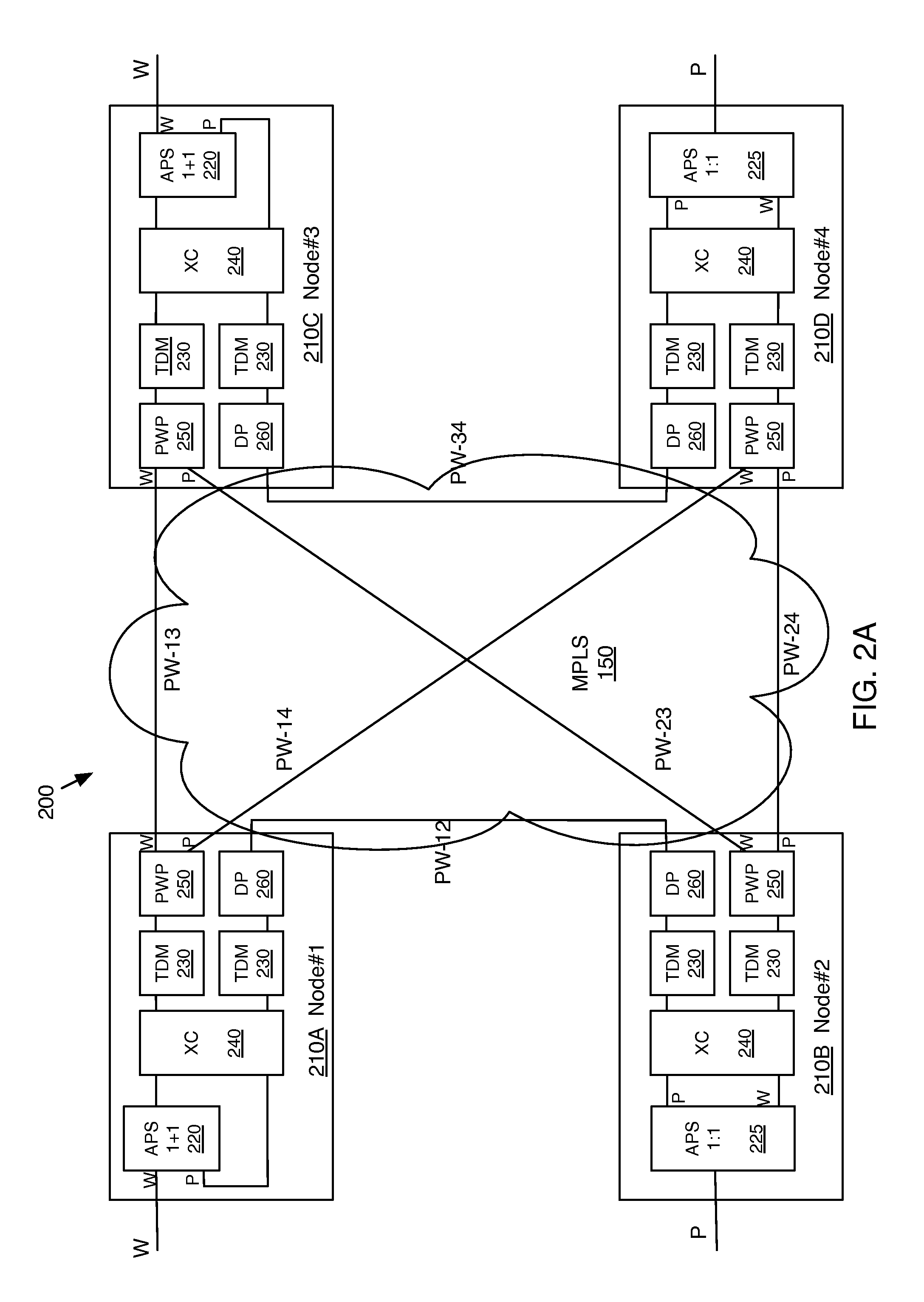Method for supporting SNCP over packet network
a packet network and packet technology, applied in the field of high-availability telecommunication networks, can solve the problems of affecting the protection level, the complexity of the protection scheme, and the impact of the protection in other sub-networks
- Summary
- Abstract
- Description
- Claims
- Application Information
AI Technical Summary
Benefits of technology
Problems solved by technology
Method used
Image
Examples
first embodiment
2×2 Configuration
[0035]Among other possible embodiments, in a first exemplary embodiment of a method of supporting SNCP over packet networks, a packet sub-network is connected to two SDH sub-networks and transports one or more SDH paths that are SNCP-protected in both SDH sub-networks. In this embodiment, the packet sub-network connects to each of the two sub-network interconnection points by a working path and a protection path.
[0036]FIG. 2A is a schematic diagram of a second network 200 having four SNCP terminating nodes 210 including a first node 210A, a second node 210B, a third node 210C and a fourth node 210D. The first node 210A and the second node 210B are part of a first sub-network, and the third node 210C and the fourth node 210D are part of a second sub-network. The nodes 210 may be SNCP terminating equipment (STE), examples of which include, but are not limited to, add / drop multiplexers. The first sub-network and the second sub-network may be, for example, counter rotat...
second embodiment
2×2 Configuration with Single Node SDH
[0051]A second exemplary embodiment of a method of supporting SNCP over packet networks is shown in FIG. 3. In general, the second embodiment is similar to the first embodiment, except that according to the second embodiment, the interconnection between the MPLS sub-network 150 with the first SDH sub-network and / or the second SDH sub-network takes place over a single node, as opposed to DNI.
[0052]FIG. 3 is a schematic diagram of a third network 300 having three SNCP terminating nodes including a first node 210A, a second node 210B, and a third node 310. The first sub-network deploys a DNI connection with the MPLS sub-network 150. The first node 210A and the second node 210B are part of a first sub-network, and the third node 310 is part of a second sub-network. Unlike the first embodiment, under the second embodiment the second sub-network provides two working / protection connection pairs to the MPLS sub-network at a single node, the third node 3...
third embodiment
2×1 Configuration
[0056]In a third exemplary embodiment of a method of supporting SNCP over packet networks, here called the 2×1 scenario, a packet network is connected to two SDH sub-networks and carries an SDH path that is SNCP-protected in only one of the SDH sub-networks. In the third embodiment, the packet node is connected to two paths (working and protection) in one of the sub-network interconnection points, and to a single path in the other. As with the first and second embodiments, the packet sub-network is configured to provide the same type of path protection as an SDH sub-network using SNCP.
[0057]FIG. 4A is a schematic diagram of a fourth network 400 having three SNCP terminating nodes 410 including a first node 410A, a second node 410B, and a third node 410C. The first sub-network deploys a DNI connection with the MPLS sub-network 150. The first node 410A and the second node 410B are part of a first sub-network, and the third node 410C is part of a second sub-network. Un...
PUM
 Login to View More
Login to View More Abstract
Description
Claims
Application Information
 Login to View More
Login to View More - R&D
- Intellectual Property
- Life Sciences
- Materials
- Tech Scout
- Unparalleled Data Quality
- Higher Quality Content
- 60% Fewer Hallucinations
Browse by: Latest US Patents, China's latest patents, Technical Efficacy Thesaurus, Application Domain, Technology Topic, Popular Technical Reports.
© 2025 PatSnap. All rights reserved.Legal|Privacy policy|Modern Slavery Act Transparency Statement|Sitemap|About US| Contact US: help@patsnap.com



